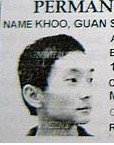The Man Who Cried (2000)
My viewing of The Man Who Cried came naturally after the strong impression left by Sally Potter’s more recent Yes (2004). Ms. Potter has made a total of 4 feature films that I’m aware of, which includes The Tango Lesson (1997) and the acclaimed Orlando (1992). Her approach has been unconventional, particularly in screenplay structure and the provisions of plot points. Character action is not the primary driving force in her stories. Instead, her narrative comes from the rhythmic flow of her protagonists’ internal world: Joan Allen’s voiced-over inner dialogue in Yes and the implicitly observed turn-of-events in The Man Who Cried.
Her films are sensitive to emotions, those deeply felt by her characters; her screenplay characters are but vehicles for conveying contemplative thought and feelings. It’s as though her flawed characters are aware of their inability to verbalize or negotiate their own circumstances, usually social or cultural. Therefore, they resort to self-reflection and particularly in the case of The Man Who Cried, Suzie (Christina Ricci) watches the turbulent setting of her life unfold quietly, thoughtfully. Suzie seems aware that the magnitude of historical events she perceives is beyond her ability to process.
The plot traces Suzie’s search to reunite with her immigrant father in America and her passage is surreal. Her life appears to flash before her eyes as her introverted nature permits very few externalized reactions against the turns of her fortunes. The film begins with a surrealistic scene of our disoriented protagonist drowning in water, surrounded by fire. Her struggle to stay afloat seems urgent enough, but the tone of this scene is far from immediate & the expressionistic use of fire burning on water (without any reference to a physical event such as a shipwreck) suggests a dramatic, metaphorical scene: she struggles alone, she’s forsaken.
The film’s entire plot is Suzie’s surreal journey from childhood to early womanhood. Music & theatrics plays a prominent role here; in fact, the scenes at the opera and it’s rehearsals clearly blends living things (like a human figure or a horse) with stage props. Sometimes a translucent veil divides the real person, an actor in the foreground with the staged scenery in the background. The use of an opera stage here is surrealism at its most deliberate in The Man Who Cried.

